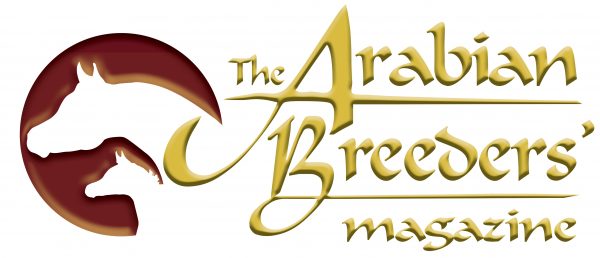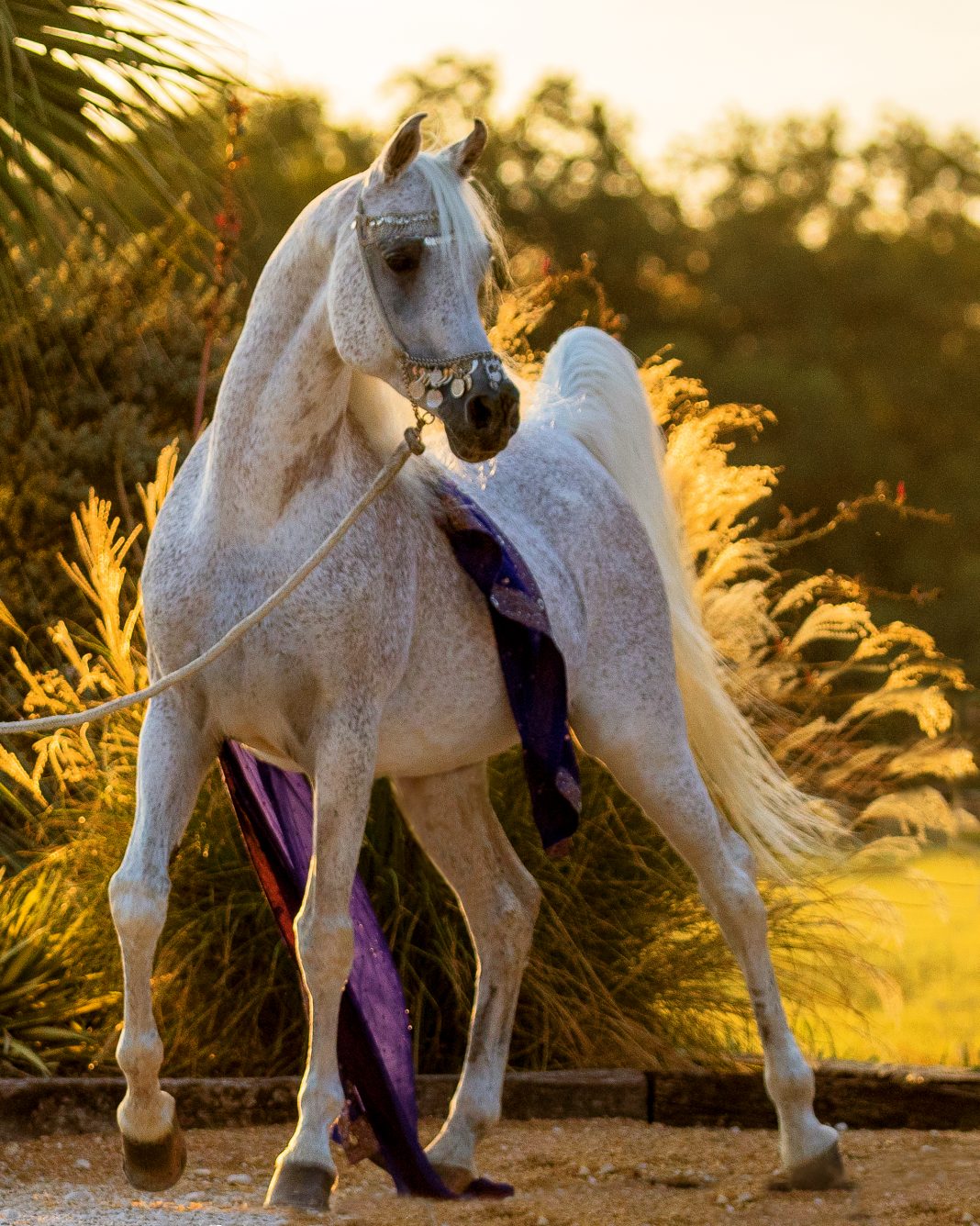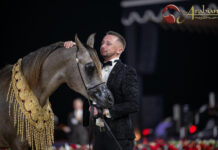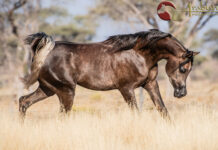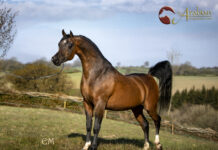The Breeders Interview – Kehilan Arabians, USA
In every edition of The Arabian Breeders’ Magazine, we speak to a selection of breeders from around the world about their experiences and successes with their breeding programme. We are delighted to share some of these incredibly insightful features online.
The Arabian Breeders’ Magazine (TABM): Please share with our readers a short background of your farm.
Becky Rogers, Kehilan Arabians, USA: How many little girls have wanted an Arabian after reading Walter Farley’s The Black Stallion? I was one of those little girls and had been blessed with a mother, Jean Rogers, who had loved horses since childhood and an older sister, Nancy Rogers Blankenship, that also had the ‘horse gene’. I had a Welsh pony at age nine and rode and competed throughout my youth, but always the dream of a pure blood Arabian was there.
In 1980 while still in College, I saved my money earned working on breaks and purchased an Egyptian sired Arabian named Khojash (Khofo x Jashue). My mother and sister joined with me showing and soon we owned a couple of Egyptian-sired mares. And thus Kehilan Arabians was born. The name Kehilan was chosen not in honour of the strain, as the concept of strains was yet to be learned by us! Rather, it was for the literal meaning of ‘purest in blood’. One thing led to another and soon I was training and showing Arabians as I had a knack for turning spirited horses into show-ring winners. At one show in 1982, we took a break in the stands to eat dinner while the world renowned Gleannloch Farms had a presentation for the stallions Sakr+++ (Sultann x Enayat) and Ibn Morafic+++ (Morafic x Kahramana) retiring from the show-ring after achieving their Legion of Merit awards; the + denotes the award they received that night. The lights were dimmed and these two white stallions floated out into the spotlight and just shimmered. The quality of the original Bedouin horse was apparent from our position up in the seats. It was magical. That moment was indelibly etched in my mind and the silhouette of those two horses in the silver light has served as an inspiration. We met Tom and Rhita McNair, the trainers for Gleannloch, at that show and although we owned Egyptian-sired Arabians at the time, with their encouragement we knew that we would focus on the Straight Egyptian Arabian going forward.
We continued to show and train horses professionally until 1994, always breeding our Straight Egyptian programme as well. In 1994, I stepped away from the show-ring to focus on our Straight Egyptian breeding programme, which was blossoming. So here we are, 37 years from the beginning, and most of the bloodlines we breed have a strong influence from the Gleannloch programme, and it is rather serendipitous that my first Arabian horse purchase was sired by a Gleannloch import – Khofo (Morafic x Nabilahh).
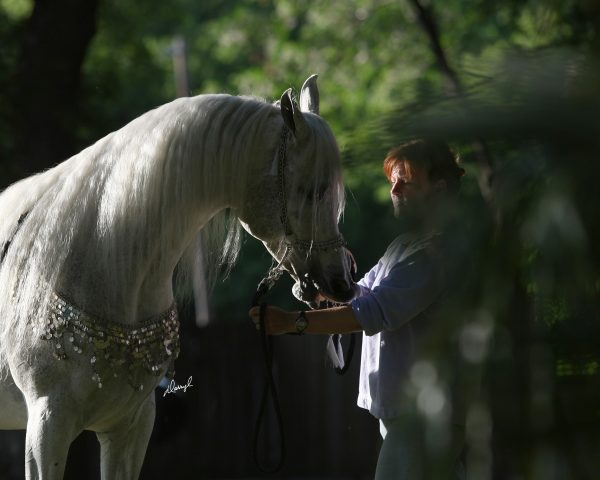
Becky and “Bubba” (Makhnificent KA). Credit Darryl.
TABM: What have been the bloodlines that you have focused on, and why did you choose them? Has this focus changed over the years?
Becky: Naturally, with our beginning in the Straight Egyptian horses influenced by Gleannloch, our bloodlines have strong ties to their horses. But, sometimes fate and intuition have played a part as well. Endings are often beginnings.
The first Straight Egyptian mare we were able to obtain was a Sultann (Sameh x Lubna) daughter in foal to Ruminaja Bahjat (Shaikh Al Badi x Bint Magidaa), who was purchased upon the advice of Janice Bush, then farm manager for Somerset Farms, the home of Bahjat. A few years later with the tragic death of Somerset’s owner Leonor Romney, Janice was searching for a suitable lifetime home for the famous Sultann. Sultann was the sire of Sakr and grandsire of Nabiel (Sakr x Magidaa), both household names in the Egyptian Arabian world. I bumped into Janice while working at the final Bentwood Farms sale. And Sultann came to Texas! He was quite senior at the time at 26 years old and I thought surely he would only live a few more years. He graced us with his presence for ten more years until the ripe age of 36.
In 1992, another ending became a beginning when Gleannloch closed its doors and we united with Janice Bush once again as part of a partnership, with the sole purpose of purchasing Makhsous (Sultann x Nabda) at the Gleannloch Final Legacy Sale. Makhsous was a horse Lee Romney had tried to buy for Somerset Farms. We were successful and Makhsous came to Kehilan to join his sire, Sultann. The first foal born to Makhsous at Kehilan was out of a Somerset-bred mare owned by Janice and became our senior sire Marquis I (ex Antigua Dance by Ruminaja Bahjat). So some of the focus was by choice, some by fate, and much by intuition, and all were related to the vision in our minds of the Gleannloch stallions in the silver light.
Through the years our primary focus has not changed but as guardians of this treasure that is the Arabian horse – we always strive for improvement. With that goal have come additions in bloodlines as needed over the now six and seven generations of Kehilan breeding. However, we did realise at some point that we were one of the only farms preserving the lines of Sameh in concentration, and we embraced that as an important contribution to Egyptian Arabian breeding.
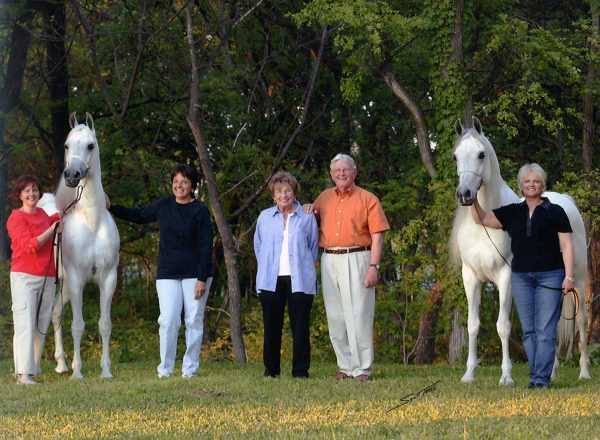
Left to right Becky Rogers Makhnificent KA Janice Bush Jean and Herb Rogers Marquis I Nancy Rogers Blankenship. Credit Scott Trees.
TABM: What were your breeding goals when you first started? Have they changed over the years?
Becky: A vision is always unique to the creator. With my background in performance training, athletic ability is a must, and the Sameh bloodlines lend themselves to that use. The heart-stopping uniquely floating movement with the tail flagged high is a trait we do not compromise on. Same, too, with the intelligence, spirit and charisma that denotes an Arabian and which we feel can be reflected in their eyes – another characteristic important to us.
Kehilan has studiously selected the best traits of the Sameh horses; balance, symmetry, strength, intelligence, motion and charisma, and combined it with bloodlines that have added beauty, grace, vitality, elegance and refinement. The result is an Arabian of extreme type and classical proportions, that dances with tail held high and is adorned with luminous eyes reflecting the magic of the ages. The details may have changed over the years – such as adding more length of leg or a bit more dish to the face – but the goal has not changed. At Kehilan we strive to produce a horse that is easily identified as an Arabian and furthermore readily defined as a Straight Egyptian Arabian, with the distinct type, classical proportions and historical character that has defined the breed for thousands of years.
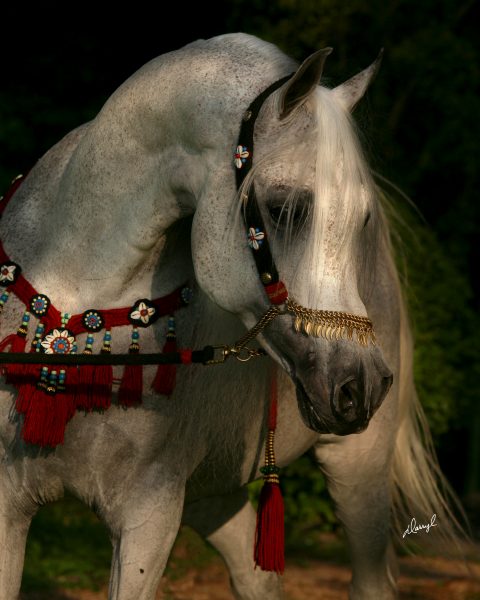
Makhnificent KA (Makhsous x Star Bint Hafiza). Credit Darrly.
TABM: Please share key moments that stand out in the early stages of your breeding programme?
Becky: Very early, we were blessed to be friends with Bill and Pat Trapp of Arabest Farms and also Burt and Sheri Melton of Rinconada Arabians. We joined the Nabiel Syndicate and one turning point toward the end of Nabiel’s illustrious career, was when the syndicate wanted to give Nabiel access to other geographical areas; transported semen was in a fledgling state, and Nabiel did not ship. Kehilan hosted the venerable stallion for two years in Texas and through this opportunity, we met and learned from many breeders worldwide.
No doubt the single largest turning point after that was the purchase of Makhsous in 1992, that brought not only Makhsous but one of the Makhsous partners – Janice Bush – to Kehilan. Both Makhsous and Janice helped Kehilan go forward in leaps and bounds. My mother, Jean, loved Makhsous – she never failed to light up when Makhsous pranced by for farm showings. She watched one day as we video taped a beautiful but petite bay mare that was at the farm to sell. She told me she wanted to breed that mare to Makhsous. I was not so sure. Makhsous himself was not a tall horse; in fact, he was only large in stature in his mind! But when mother made up her mind, there would be no stopping her. She purchased the mare for herself, not for the farm, and bred her to Makhsous. I questioned her on the length of leg and height issue and she gave a reasonable answer in that both Makhsous and the mare, Star Bint Hafiza (Ibn Dahman x AK Amiri Fayrouz), had tall parents. But then she said it was simple as she was breeding the two horses together that made her heart sing. Hard to argue with that one! The resulting foal, who she named Makhnificent KA, became the cornerstone of our farm. And to this day, is the King at Kehilan, alongside his half- brother Marquis. Fate and intuition strike again.
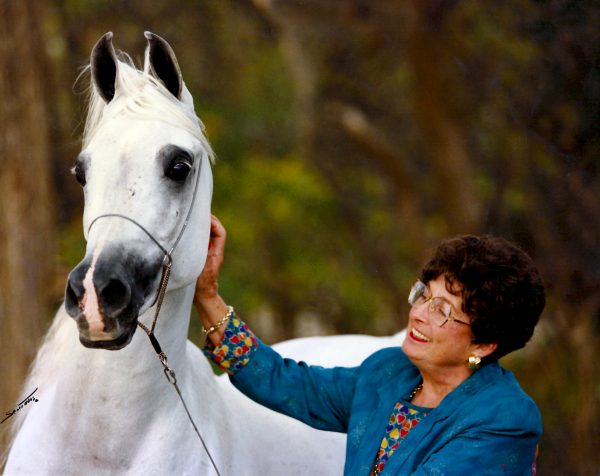
Makhsous (Sultann x Nabda) and Jean Rogers. Credit Scott Trees
TABM: When was it that you realised that you were a successful breeder? And what, in your opinion, defines a ‘breeder’?
Becky: Do you realise you are a ‘successful’ breeder? Or do you realise you have had some success while breeding and hope, one day in the future, that someone is proud to own a horse whose ancestry is due to your contributions? Then you will be a successful breeder. I think it does not matter whether you breed one foal a year or fifty foals a year, you are a breeder when you have a dream and a vision that you pursue over multiple generations. For instance, we are a family endeavour with an average of ten foals a year and it has required dedication, passion and perseverance to try and achieve the vision we have of our ideal Arabian.
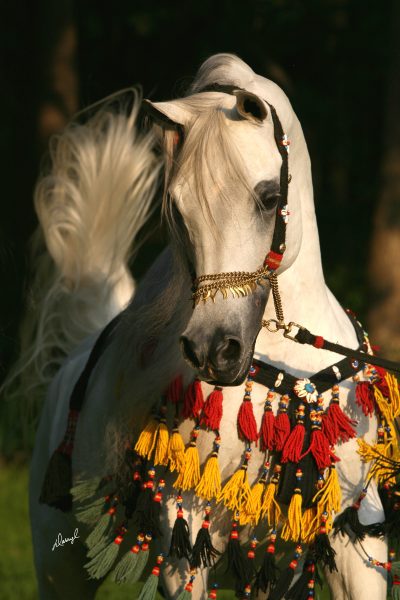
Marquis I (Makhsous x Antigua Dance) age 9. Credit Darryl.
TABM: As a breeder, how do you feel about the showing world? Do you think that changes are needed to celebrate breeders more?
Becky: This is a question that many across the Arabian horse community are struggling with in today’s fast paced and technological world. We have shown through the years and had success when we have done so. More recently, we have not shown our horses for a variety of reasons. Many of which mirror the reasons given by other breeders: the need for the horse to leave the farm for a substantial time period to be trained – we used to train and condition at our farm, and thus we had many more opportunities to show; the cost of the training and showing; the current way in which the horses are exhibited and the stress it brings to the horse; the difficulty in finding fair venues for the horses to be judged. And so on. On the other hand, showing can be an effective marketing tool and good publicity for the farm. There is no easy answer.
I think many of the performance events certainly showcase the athletic ability and intelligence of the Arabian horse. But in the United States at least, I worry that we have become so very competitive in each division that we are creating ‘specialised Arabians’ and that with time, breeding to be able to win at that high level in certain divisions ignores the traits that made the Arabian a unique, tough war horse that is adaptable in a harsh climate. Over time if you breed for speed, the horse begins to look like a thoroughbred. If you breed for a high trot, it will be conformed more like a Saddlebred, and so on. The Arabian was the original versatilist, and not a specialist save for endurance. One mistake we made was removing the characteristic of ‘breed type’ as a judging factor in the performance classes. Especially the Championships. It should be put back.
In the ‘halter’ or in-hand classes we have an entirely different conundrum. The stance that has developed over the years, which is to mimic a stallion courting a mare, has become more and more extreme. The best trainers can hide many faults with this stance. The stress on some horses to hold this extreme stance is cruel. Finally, to those outside our industry, the very people we hope to entice to become future breeders, this stance appears odd at best and crazy at worst. The extreme grooming and clipping that seems normal to the trainers is ridiculed by nearly every owner, and certainly the newcomers who view the horses. It does not enhance but rather detracts from the beauty of the Arabian.
Nearly every person I know falls in love with this breed when they are in a more natural setting – turned loose, snorting, prancing and then greeting the visitor for cuddles. The challenge is how do we reconfigure the in-hand classes today to attempt to tap into that magic that is the Arabian horse, while providing an entertaining and exciting venue to showcase the best horses? As the current President of The Pyramid Society, I have personally been involved in rewriting the criteria for the in-hand stand-up for our flagship show, The Egyptian Event. We have softened the stance and put rules in place to curb abuse. We highlight the entrance and movement of the horse. We are very strict about the clipping and grooming and ask for a more natural, but still groomed look. However, the class is still run basically the same and I think it is time to think outside the box to a different type of class. Perhaps ‘classes’ or credentialing for breeders that can incorporate not only the judging of the conformation but also showcase the horse at liberty for a portion.
Whatever the answer, I do feel we need to celebrate breeders more. It is imperative that breeders, large and small, remain in our industry. They provide the palette of colours for everyone to create their own painting.
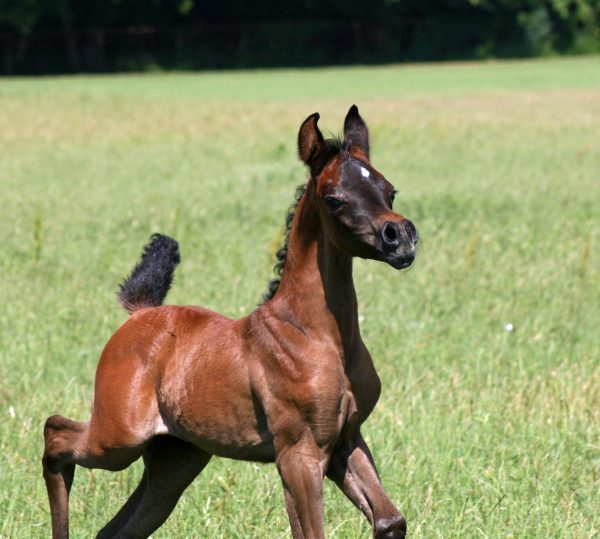
Naafisah KA (Makhnificent KA x Isabella KA by Marquis I). Credit Kehilan Arabians archives.
TABM: Do you think that breeders are a dying breed, pardon the pun?
Becky: Breeders may not be a dying breed… But they could be considered to be on the ‘threatened list’ and heading towards an ‘endangered species’.
There are many factors for this, including the difficulty for breeders to be recognised and appreciated for their contribution to the Arabian industry at large. It is so easy to buy a horse and have success. Not as easy to breed and have the success, and very difficult to breed over multiple generations with still success. And some factors are totally out of our control. If you look at history, the breeding of horses has enjoyed periods of relative popularity and had periods where it was challenging – usually due to shifts in economic status, government styles, and even cultural trends.
However, we now face some global factors that are quite challenging. Worldwide, the cost of running breeding programmes for leisure is skyrocketing. Obtaining feed in a world where feeding humans is getting harder is expensive. Perhaps even more alarming is culturally, we have entered the digital age and many young people are no longer exposed to horses or any type of livestock. Their entertainment is via a computer chip on a phone. Their social interaction is also over that same phone. Attention spans are accordingly shorter and geared towards less nature oriented hobbies. The good news it that the passion for horses is out there in many little girls and boys, somewhere, and that same digital world does allow for worldwide promotion of our most wonderful horse. The trick is getting these would be Arabian trustees to actually experience the horse in person. For once that happens, as we all know – they will be hooked.
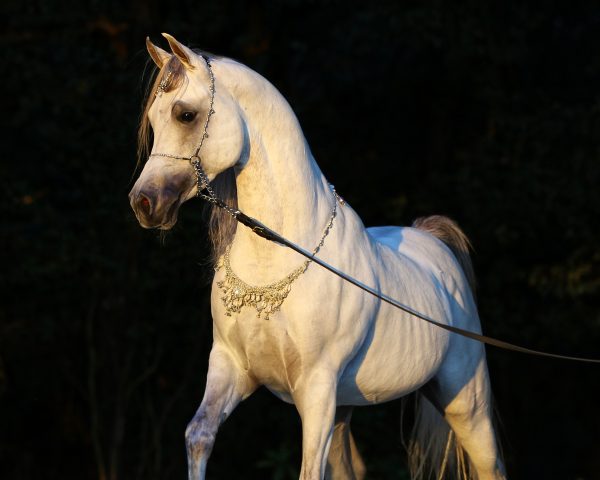
Sakhr KA (Makhnificent KA x Simpli Iresistibl). Credit Janice Bush.
TABM: Do you think that breeders and dedicated breeding programmes still have a place in the world today?
Becky: YES! We are guardians of this treasure that is the Arabian horse. Someone, somewhere, has always taken care of this breed for thousands of years. Across continents, across time. Without the breeder of one foal or many foals, we would not have the horses we love today. Dedicated programmes are so valuable to the overall genetic health of the Arabian breed, so their horses can be utilised by other breeders and owners as one colour in the creation of that painting. A world without that dedication would simply be about prizes, ego, and a short-term high. We would lose the hallmarks that make the Arabian horse a distinct breed. Those breeders who toil not for the ribbon or money, but for the foal that stands on shaky legs and melts the heart of the breeder who planned and nurtured that mare and foal, for whom that foal was a vision in their mind – they are the reason we still have this horse, millennia after it began to occupy the tents of its caretakers. Every person who wants to show an Arabian or just trail ride their best friend down the lane can thank that breeder somewhere, in some time period, that chose to breed the great-great grandparents of their cherished companion.
TABM: Over the years, what have been your key successes, perhaps the ones that define your farm?
Becky: Many would expect me to list show wins here but although they have been key, I do not think they are at the top of my list. Through the years, this magical journey has led us to meet many soul mates who share our love and passion for this most wonderful of horses. We have travelled the world and seen different cultures, climates and topography, and met people from many different backgrounds and faiths, but always the friendship and shared excitement for the Arabian horse has been the common thread that unites us. A shared appreciation of beauty, grace and noble spirit, along with the task of preserving and perpetuating such a historical creature brings breeders together from all walks of life.
We are particularly proud that our horses are ‘breeders’ horses’ and being used in the programmes of our friends worldwide. In fact, there are Kehilan horses now in residence in over 21 countries! I love to hear when someone notes that one of our horses they see elsewhere has a ‘Kehilan’ style. We have tried to represent our horses with honesty and integrity, and to produce horses that their caretakers are proud to have. Doug Marshall of Gleannloch Farms was quoted as saying: “I’d like to think that what we’ve done for the breed is try to be helpful, in encouraging people not only to get the horses, but to be happy with them. And if we can keep on with that philosophy, that’s all we want.” We feel the same way.
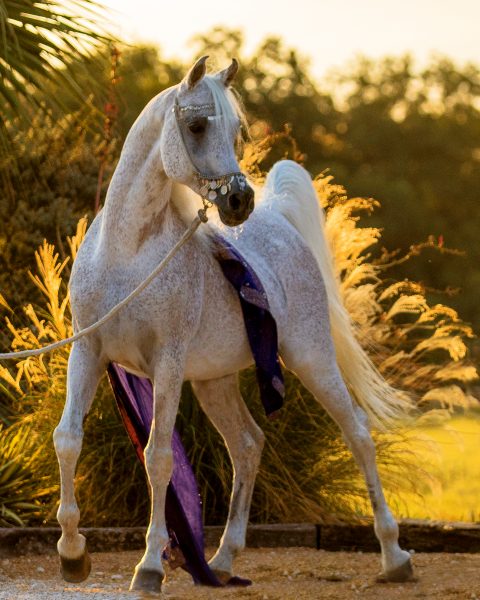
Makhnificent KA at 20. Credit Janice Bush.
TABM: And finally, what is next for you and your breeding programme?
Becky: We are expecting sixteen foals in 2017 for us and for Azizah Arabians of Australia, whose horses are based on our programme and reside with us. As we move to more often using the sons of Marquis and Makhnificent – now 24 and 22 respectively – it represents a new set of challenges and excitement. We will have to find the next step forward as it is time for another outcross and we are trying different bloodlines to add in for that step.
One goal I have for the near future is to begin visiting farms again more regularly. It is hard to find the time with the responsibilities of being a hands-on owner who does all the breeding and foaling. However, when we started, we visited farms far and wide as there was not an internet or Facebook to see photos and videos of horses. It was so important and gave us a great foundation by learning from the many breeders we visited. Many of those breeders became good friends.
If I could give some advice to the new breeders, it would be that there is no substitute for seeing these horses in person. For it is in the flesh where the character, spirit, joie de vivre and intelligence shines through and touches your heart. It is where you can ask questions of the breeder, and strive to understand their vision and what has worked and what has not. It is also where you can refine your own dream. It is where we can learn to go forward together as caretakers and guardians of the Arabian horse, and leave the next generation of breeders a great foundation.
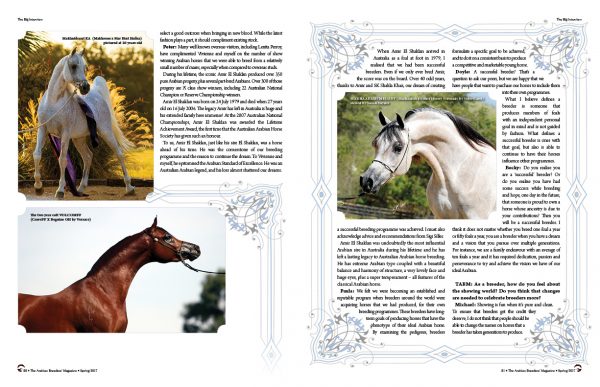
First printed in The Arabian Breeders’ Magazine Volume I Issue III March 2017. To enjoy further content such as this, please visit The Arabian Magazine Shop.
